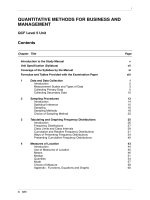btec level 5 hnd unit 19 research project
Bạn đang xem bản rút gọn của tài liệu. Xem và tải ngay bản đầy đủ của tài liệu tại đây (1.22 MB, 28 trang )
<span class="text_page_counter">Trang 1</span><div class="page_container" data-page="1">
<b>ASSIGNMENT 01 FRONT SHEET</b>
<b>Unit number and titleUnit 19: Research Project </b>
</div><span class="text_page_counter">Trang 3</span><div class="page_container" data-page="3">PAGE 2
</div><span class="text_page_counter">Trang 5</span><div class="page_container" data-page="5"><b>Grade:Assessor Signature:Date:</b>
</div><span class="text_page_counter">Trang 6</span><div class="page_container" data-page="6">PAGE 2
</div><span class="text_page_counter">Trang 7</span><div class="page_container" data-page="7"><b>ENVIRONMENTAL PROTECTIONRESPONSIBILITIES OF BUSINESSES IN THE</b>
<b>ELECTRIC VEHICLE MANUFACTURINGINDUSTRY</b>
NGUYEN HUU THANH PHATGBS1007B
University of Greenwich (Vietnam)
2. PROBLEM STATEMENT:
</div><span class="text_page_counter">Trang 8</span><div class="page_container" data-page="8">Corporate environmental responsibility (CSR) plays a crucial role in reducing global climatechange and environmental pollution. As society modernizes, the demand for goods and servicesincreases, leading to overproduction and heavy environmental pollution. The author finds theresponsibility of electric vehicle manufacturing enterprises in environmental protection andreducing the loss of natural resources to be an interesting research topic. Pollution emissions andresource depletion are driving people to seek alternatives to internal combustion engine vehicles(ICEVs). Electric vehicles (EVs) are often regarded as the ideal solution to these issues. This willbe the cause that affects the environmental protection responsibility of electric vehiclecompanies (Guo et al., 2021). In Vietnam, while public transportation is not yet available PAGE 2
</div><span class="text_page_counter">Trang 9</span><div class="page_container" data-page="9">personal vehicles have become the primary mode of transportation for meeting people's traveldemands. According to a United Nations research, Vietnam leads Southeast Asia in personalvehicle dependence, with motorbikes accounting for over 80% of traffic demand in towns withexceptional mobility advantages. Flexible, appropriate for urban movement, as well as areasonable price and minimal operating costs. City. Every day, around 6.2 million motorcycles,600,000 cars, and 1 million vehicles enter and exit Ho Chi Minh City. Hanoi has approximately5 million motorcycles and 535,000 automobiles. With increased urbanization and an increase inthe number of gasoline-powered vehicles, traffic congestion and air pollution have becomeissues that must be addressed (Văn & Đức, 2020). The primary reason for environmentalprotection from electric vehicle businesses is that, as the world grapples with the challenges ofclimate change, air pollution, and diminishing fossil fuel reserves, the transition to electricvehicles is seen as an important step towards a more sustainable future(Phương & Hoàng, 2023).
3. RESEARCH OBJECTIVE:
In this study, the author's purpose is to conceptualize saving natural resources as theresponsibility of electric vehicle manufacturing enterprises in the current context. The first goalis to redefine the environmental protection responsibility of businesses in the electric vehiclemanufacturing industry. Next, conduct research to identify environmental pollution factorsaffecting the Enterprise's electric vehicle production activities. Finally, recommendations aremade on assessing the current status of enterprises' production decisions and solutions to solve
</div><span class="text_page_counter">Trang 10</span><div class="page_container" data-page="10">this problem. The research questions will be:
- What factors affect the environmental protection responsibility of electric vehiclemanufacturing enterprises?
- How does air pollution affect the environmental protection responsibility of electricvehicle manufacturing enterprises?
- How does the exploitation of many fossil materials affect the environmental protectionresponsibility of electric vehicle businesses?
- How does wasting lithium-ion batteries affect the environmental protection responsibility of electric vehicle businesses?
PAGE 2
</div><span class="text_page_counter">Trang 11</span><div class="page_container" data-page="11">In the context of electric vehicle manufacturing, CSR takes the form of environmentalprotection responsibilities. These responsibilities are defined as prioritizingenvironmental issues by managing social responsibility programs that promoteenvironmental protection (Andrei, Panait, & Ene, 2014). This means that electric vehiclemanufacturers are expected to implement practices that reduce pollution, conserveresources, and promote sustainability.
The environmental responsibilities of electric vehicle manufacturers are influenced by
</div><span class="text_page_counter">Trang 12</span><div class="page_container" data-page="12">several factors. One of these is air pollution. The manufacturing process of electricvehicles, particularly the batteries, can contribute to air pollution if not properlymanaged. Therefore, electric vehicle manufacturers have a responsibility to implementpractices that minimize air pollution.
Another factor is the overexploitation of fossil fuels. The production of electric vehiclesrequires energy, and if this energy comes from fossil fuels, it can contribute to theoverexploitation of these resources.Therefore, electric vehicle manufacturers have aresponsibility to minimize their reliance on fossil fuels, for instance, by using renewableenergy sources in their production processes.
PAGE 2
</div><span class="text_page_counter">Trang 13</span><div class="page_container" data-page="13">A third factor is waste management practices associated with lithium-ion batteries. Thedisposal of used lithium-ion batteries poses a significant waste management challenge, asthey contain various hazardous materials that can harm the environment if not properlydisposed of. Therefore, electric vehicle manufacturers have a responsibility to implementeffective waste management practices for lithium-ion batteries.
In conclusion, the environmental protection responsibility of electric vehiclemanufacturers, as a form of CSR , involves the integration of environmental concerns intheir operations, influenced by factors such as air pollution, overexploitation of fossilfuels, and waste management practices associated with lithium-ion batteries (Hoang PhucBao, 2022).
<b>4.2. Air Pollution</b>
Air pollution, a significant environmental issue, is primarily caused by human activities,particularly the burning of fossil fuels for transportation, electricity generation, andindustrial processes (Daly & Zannetti, 2007) . The release of pollutants into theatmosphere can have severe health impacts, including respiratory diseases and otheradverse health effects. Moreover, air pollution contributes to global climate change byincreasing the concentration of greenhouse gases in the atmosphere (Bai et al., 2018).Electric vehicles (EVs) have emerged as a potential solution to mitigate air pollution.
</div><span class="text_page_counter">Trang 14</span><div class="page_container" data-page="14">Unlike conventional vehicles that burn fossil fuels and emit pollutants, EVs produce zerotailpipe emissions, thereby significantly reducing the emission of pollutants. Thisattribute of EVs is particularly beneficial in urban areas, where air pollution is often amajor concern.
However, the environmental impact of EVs is not limited to their operation. Themanufacturing process of EVs and their batteries can also contribute to air pollution. Forinstance, the production of lithium-ion batteries, which are commonly used in Evs ,involves energy-intensive processes that can result in the emission of pollutants if theenergy used is derived from fossil fuels.
PAGE 2
</div><span class="text_page_counter">Trang 15</span><div class="page_container" data-page="15">Moreover, the source of electricity used for charging EVs can also influence theirenvironmental impact. If the electricity is generated from renewable sources, such aswind or solar power, the use of EVs can result in a net reduction in air pollution.However, if the electricity is generated from fossil fuels, the benefits of EVs in terms ofreduced tailpipe emissions could be offset by the emissions from electricity generation(Guo et al., 2020).
Therefore, while EVs have the potential to significantly reduce air pollution, it isessential to consider the entire life cycle of EVs, from manufacturing to operation anddisposal, to fully understand their environmental impact. It is also crucial to transitiontowards renewable sources of energy for electricity generation to maximize theenvironmental benefits of EVs.
<b>4.3. Overexploitation Of Fossil Raw Materials</b>
The overexploitation of fossil fuels, such as coal, oil, and natural gas, for transportation and other purposes is a significant environmental concern. These resources, formed over millions of years from the remains of plants and animals, are non-renewable and their excessive exploitation leads to their rapid depletion. This not only threatens the availability of these resources for future generations but also contributes to environmentalpollution and climate change due to the release of greenhouse gases during their extraction and use (Lithaco, 2023).
</div><span class="text_page_counter">Trang 16</span><div class="page_container" data-page="16">( , )
Electric vehicles (EVs) have emerged as a potential solution to mitigate the overexploitation of fossil fuels. Unlike conventional vehicles that run on gasoline or diesel, EVs are powered by electricity, which can be generated from various sources, including renewable ones such as wind and solar power. Therefore, the adoption of EVs can help reduce the dependence on fossil fuels for transportation, thereby contributing to the conservation of these resources.
However, it’s important to note that the production of EVs,particularly the batteries, requires significant amounts of energy and raw materials. The manufacturing of lithium- PAGE 2
</div><span class="text_page_counter">Trang 17</span><div class="page_container" data-page="17">ion batteries, which are commonly used in EVs, involves energy-intensive processes andthe use of various metals, some of which are scarce. If the energy used in these processes is derived from fossil fuels,it can offset the environmental benefits of EVs. Moreover, theextraction of these metals can also have environmental impacts, including habitat destruction and water pollution (Hoang Phuc Bao, 2022).
Therefore, while EVs have the potential to reduce the overexploitation of fossil fuels, it’s crucial to consider the entire life cycle of EVs, from manufacturing to operation and disposal, to fully understand their environmental impact.It’s also important for electric vehicle manufacturers to implement practices that minimize the environmental impact of their production processes, as part of their environmental protection responsibilities. This includes optimizing the energy efficiency of their manufacturing processes, using renewable energy sources, and implementing effective waste management practices for used batteries.
<b>4.4. Waste Management Practices Associated with Lithium-ion Batteries</b>
The production and disposal of lithium-ion batteries, which are extensively used in electric vehicles (EVs), pose significant environmental challenges. The manufacturing process of these batteries is energy-intensive, requiring the use of various raw materials,
</div><span class="text_page_counter">Trang 18</span><div class="page_container" data-page="18">including lithium, cobalt, and nickel. Some of these materials are scarce and their extraction can lead to environmental degradation and socio-economic issues in the regions where they are mined (Mrozik et al., 2021).
Moreover, at the end of their life cycle, lithium-ion batteries become a significant waste management challenge. These used batteries contain various hazardous materials that canharm the environment if not properly disposed of. Improper disposal can lead to soil and water contamination, posing risks to ecosystems and human health (Mrozik et al., 2021).
PAGE 2
</div><span class="text_page_counter">Trang 19</span><div class="page_container" data-page="19">Therefore, the development and implementation of effective waste management practicesfor lithium-ion batteries are crucial for minimizing the environmental impact of electric vehicles. This includes practices such as recycling and repurposing used batteries. Recycling involves the extraction of valuable materials from used batteries for use in the production of new batteries. Repurposing, on the other hand, involves the use of used batteries for less demanding applications, such as energy storage in renewable energy systems, after their use in EVs (Mrozik et al., 2021).
However, these waste management practices also have challenges. For instance, the recycling process is complex and energy-intensive, and repurposing requires ensuring thesafety and reliability of used batteries. Therefore, ongoing research and innovation are needed to improve these practices and develop new, more sustainable solutions for the management of used lithium-ion batteries (Mrozik et al., 2021).
In conclusion, while EVs have the potential to significantly reduce the overexploitation of fossil fuels and air pollution, it’s crucial to address the environmental challenges associated with the production and disposal of lithium-ion batteries to fully realize the environmental benefits of EVs. This underscores the importance of the environmental protection responsibilities of electric vehicle manufacturers, which include not only the production of environmentally friendly vehicles but also the sustainable management of the resources used in their production and the waste generated from their use (Mrozik et al., 2021).
</div><span class="text_page_counter">Trang 21</span><div class="page_container" data-page="21">practices that protect the environment . Please note that these are tentative hypothesesand the actual results of your study may support or contradict these hypotheses.
</div><span class="text_page_counter">Trang 22</span><div class="page_container" data-page="22">PAGE 2
</div><span class="text_page_counter">Trang 23</span><div class="page_container" data-page="23">Air Pollution
Overexploitation of FossilRaw Materials
EnvironmentalProtectionResponsibility of
Electric VehicleEnterprisesReusing lithium-ion
batteries with Lithium-ionBatteries
positively influence(Guo et al., 2020)
positively influence(Lithaco, 2023)
positively influence(Mrozik, W., Rajaeifar, M. A., Heidrich, O., & Christensen, P, 2022)
</div><span class="text_page_counter">Trang 24</span><div class="page_container" data-page="24">PAGE 2
</div><span class="text_page_counter">Trang 25</span><div class="page_container" data-page="25">Andrei, J., Panait, M., & Ene, C. (2014). Environmental protection between social responsibility,green investments and cultural values.
Bai, L., Wang, J., Ma, X., & Lu, H. (2018). Air pollution forecasts: An overview. Internationaljournal of environmental research and public health, 15(4), 780.
Daly, A., & Zannetti, P. (2007). An introduction to air pollution–definitions, classifications, andhistory. Ambient air pollution. P. Zannetti, D. Al-Ajmi and S. Al-Rashied, The Arab School forScience and Technology and The EnviroComp Institute, 1-14.
Guo, J., Zhang, X., Gu, F., Zhang, H., & Fan, Y. (2020). Does air pollution stimulate electricvehicle sales? Empirical evidence from twenty major cities in China. Journal of CleanerProduction 249, , 119372.
Guo, Z., Li, T., Peng, S., & Zhang, H. (2021). Environmental and economic consequences of theincentive policy on electric vehicle industry: A CGE based study in China. Resources,
</div><span class="text_page_counter">Trang 26</span><div class="page_container" data-page="26">Conservation and Recycling, 169, 105542.
Mạnh, T. S. N. H., Tín, T. S. K. T., Đơng, T. S. T. V., & Sơn, T. S. T. T. GIẢI PHÁP GIẢM ƠNHIỄM MƠI TRƯỜNG VỚI HỆ THỐNG TUẦN HỒN KHÍ THẢI EGR. BOV MƠI TRƯNG, 1.
Manisalidis, I., Stavropoulou, E., Stavropoulos, A., & Bezirtzoglou, E. (2020). Environmentaland health impacts of air pollution: a review. Frontiers in public health 8, , 14.
Nichols, B. G., Kockelman, K. M., & Reiter, M. (2015). Air quality impacts of electric vehicleadoption in Texas. Transportation Research Part D: Transport and Environment 34, , 208-218.
PAGE 2
</div><span class="text_page_counter">Trang 27</span><div class="page_container" data-page="27">Pan, S., Roy, A., Choi, Y., Eslami, E., Thomas, S., Jiang, X., & Gao, H. O. (2019). Potentialimpacts of electric vehicles on air quality and health endpoints in the Greater Houston Area in2040. Atmospheric Environment 207, , 38-51.
Thắng, N. N. (2010). Gắn quản trị nhân sự với trách nhiệm xã hội của doanh nghiệp. Tạp chíKhoa học ĐHQGHN, Kinh tế và Kinh doanh, 26, 232-238.
Văn, N. N., & Đức, N. H. (2020). NGHIÊN CỨU XU HƯỚNG ĐIỆN KHÍ HĨA GIAOTHƠNG Ở VIỆT NAM VÀ ĐÁNH GIÁ KINH TẾ KỸ THUẬT TRẠM SẠC XE ĐIỆN HAIBÁNH TÍCH HỢP ĐIỆN MẶT TRỜI TẠI TỊA NHÀ E. TOWN 2-TP. HỒ CHÍ MINH.Mrozik, W., Rajaeifar, M. A., Heidrich, O., & Christensen, P. (2021). Environmental impacts,pollution sources and pathways of spent lithium-ion batteries. Energy & EnvironmentalScience 14, (12), 6099-6121.
Kotak, Y. et al. (2021) ‘End of electric vehicle batteries: Reuse vs. Recycle’, Energies, 14(8), p.2217.
</div>








